May marks the vibrant peak of spring, where the garden bursts into a kaleidoscope of colors and life. It’s a pivotal month for gardeners, offering ample opportunities to sow a variety of seeds and nurture the growth of vegetables, herbs, fruits, and flowers. With the threat of frost behind us and the warmth of the sun embracing the earth, May presents the perfect window for planting, hardening off seedlings, and transplanting, ushering in a new chapter of growth and abundance. Let’s explore together What to Plant in May: Vegetables, Flowers, Herbs and Fruits per USDA Zone. Discover what plants can be directly sown into the ground, which ones benefit from starting seeds indoors, and which ones are ready for transplanting as seedlings in May, categorized by different hardiness zones.
Before starting, I suggest checking your specific hardiness zone and local weather conditions for the best timing and planting practices. You can verify your growing zone below by typing your ZIP code, as a new USDA hardiness zone map has been created since 2023.
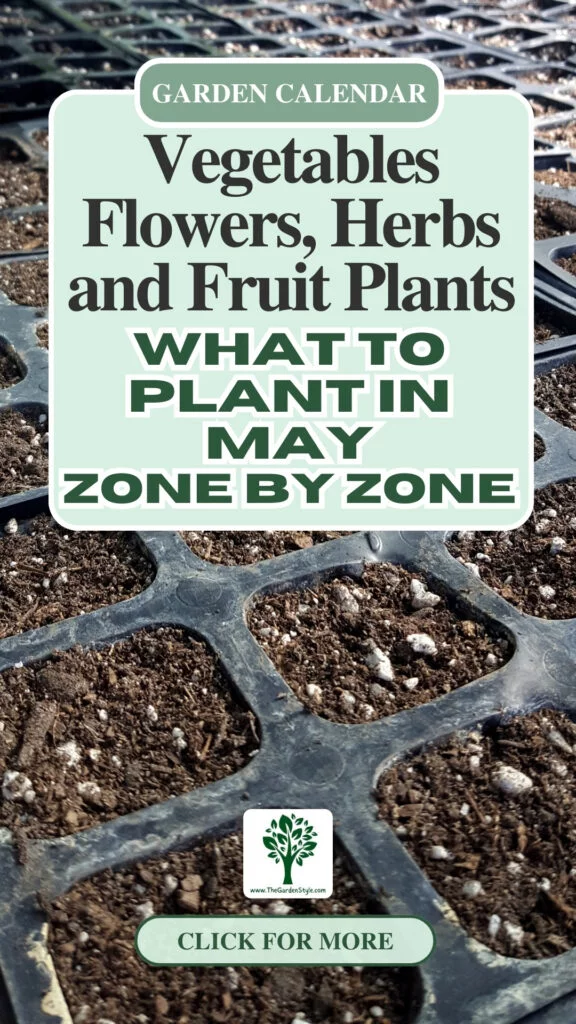
Table of Contents
Gardening Tips Before Plant in May
Here are some essential gardening tips to consider before planting in May. These tips will help you have a successful growing season and enjoy a bountiful harvest of fresh, healthy produce and vibrant flowers.
- Soil Preparation: Prepare your soil before planting. Ensure it is well-drained, loose, and rich in organic matter. Amend the soil with compost or aged manure to improve its fertility and texture.
- Weed Control: Clear the planting area of any weeds or unwanted vegetation. Weeds compete with your plants for water, nutrients, and sunlight, so it’s essential to keep them in check to promote healthy growth.
- Sunlight Assessment: Evaluate the sunlight exposure in your garden beds to determine the best placement for your plants. Most vegetables, herbs, fruits, and flowers require at least 6-8 hours of sunlight per day for optimal growth.
- Watering Considerations: Ensure your garden beds receive adequate water, especially during the warmer months of May. Consider installing drip irrigation or soaker hoses to deliver water directly to the root zone and minimize water loss through evaporation. Learn more about the best time to water plants.
- Mulching: Apply a layer of organic mulch, such as straw, wood chips, or shredded leaves, around your plants to conserve soil moisture, suppress weed growth, and regulate soil temperature. Mulching also improves soil health and reduces erosion.
- Companion Planting: Embrace the concept of companion planting by grouping together plants that benefit each other. Companion plants can help repel pests, attract beneficial insects, and improve overall garden health.
- Spacing and Planting Depth: Follow the spacing recommendations on seed packets or plant tags to ensure adequate room for your plants to grow. Plant seeds at the proper depth and transplant seedlings at the same depth they were growing in their containers.
- Frost Protection: While the risk of frost diminishes in May, it’s essential to remain vigilant, especially in cooler regions. Be prepared to cover tender plants with row covers, cloches, or makeshift protective barriers. Plastic bottles or jugs with the bottoms removed can be placed over individual plants to create miniature greenhouses, trapping heat and protecting them from frost damage. Ensure the covers are removed during the day to prevent overheating and replaced in the evenings when temperatures drop. This simple and cost-effective method can provide valuable protection during unexpected frosts in the early weeks of May.
- Support Structures: Install support structures, such as trellises, stakes, or cages, for vining plants like tomatoes, cucumbers, and peas. Proper support helps keep plants off the ground, improves air circulation, and prevents damage to fruits and foliage.
- Regular Maintenance and Pest Fighting: Keep an eye out for pests because as the temperatures rise, pests will appear. By fertilizing in advance, you can provide the nutrients needed for perfect plant development, preventing yellowing leaves. Stay on top of regular garden maintenance tasks, such as weeding, watering, fertilizing, and monitoring for pests and diseases. Address issues promptly to prevent them from escalating and causing widespread damage to your plants. When the plants are young and are already sprouting, they are prone to attack by aphids and caterpillars. Mealybugs already attack the branches of the bush. There is also the fruit fly, a pest that damages fruit trees, causing fruit to drop and rot. This aspect must be kept in mind so that the orchard is in good planting conditions. Pests can be combated naturally with neem oil. We recommend our article about how to mix neem oil for plants. Learn more about fish fertilizer for plants.
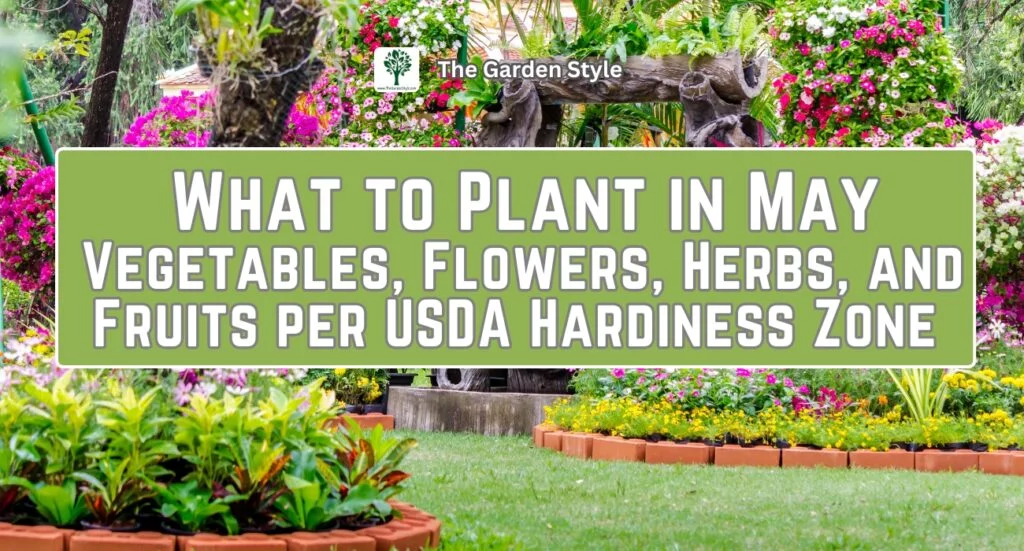
Herbs to Plant in May
Here’s a list of some culinary herb seeds to start in May in the USA, with relevant information for each:
- Basil
- Where to Start: Indoors, seedlings can be transplanted.
- Soil Temperature: 70-80°F (21-27°C)
- Preferred Location: Sunny, well-drained soil or container gardening.
- Light: 6-8 hours of direct sunlight.
- Water: Keep the soil consistently moist but not waterlogged.
- Days to Maturity: 60-90 days.
- Suggested Hardiness Growing Zones: Zones 4-11.
- Chives
- Where to Start: Indoors or outdoors, seedlings can be transplanted.
- Soil Temperature: 60-70°F (15-21°C)
- Preferred Location: Partial shade to full sun, well-drained soil or container gardening.
- Light: 4-6 hours of direct sunlight.
- Water: Water regularly, keeping the soil evenly moist.
- Days to Maturity: 80-90 days.
- Suggested Hardiness Growing Zones: Zones 3-9.
- Cilantro (Coriander)
- Where to Start: Indoors or outdoors, seedlings can be transplanted.
- Soil Temperature: 50-75°F (10-24°C)
- Preferred Location: Partial shade to full sun, well-drained soil or container gardening.
- Light: 4-6 hours of direct sunlight.
- Water: Keep the soil consistently moist.
- Days to Maturity: 60-90 days.
- Suggested Hardiness Growing Zones: Zones 2-11.
- Dill
- Where to Start: Indoors or outdoors, seedlings can be transplanted.
- Soil Temperature: 60-70°F (15-21°C)
- Preferred Location: Full sun, well-drained soil or container gardening.
- Light: 6-8 hours of direct sunlight.
- Water: Water regularly, keeping the soil evenly moist.
- Days to Maturity: 60-90 days.
- Suggested Hardiness Growing Zones: Zones 2-11.
- Mint
- Where to Start: Indoors or outdoors, seedlings can be transplanted.
- Soil Temperature: 65-70°F (18-21°C)
- Preferred Location: Partial shade to full sun, moist, well-drained soil or container gardening.
- Light: 4-6 hours of direct sunlight.
- Water: Keep the soil consistently moist.
- Days to Maturity: 90-120 days.
- Suggested Hardiness Growing Zones: Zones 3-9.
- Oregano
- Where to Start: Indoors or outdoors, seedlings can be transplanted.
- Soil Temperature: 65-70°F (18-21°C)
- Preferred Location: Full sun, well-drained soil or container gardening.
- Light: 6-8 hours of direct sunlight.
- Water: Water when the soil feels dry to the touch.
- Days to Maturity: 60-90 days.
- Suggested Hardiness Growing Zones: Zones 5-10.
- Parsley
- Where to Start: Indoors or outdoors, seedlings can be transplanted.
- Soil Temperature: 70-85°F (21-29°C)
- Preferred Location: Partial shade to full sun, moist, well-drained soil or container gardening.
- Light: 4-6 hours of direct sunlight.
- Water: Keep the soil consistently moist.
- Days to Maturity: 70-90 days.
- Suggested Hardiness Growing Zones: Zones 5-9.
- Rosemary
- Where to Start: Indoors or outdoors, seedlings can be transplanted.
- Soil Temperature: 70-80°F (21-27°C)
- Preferred Location: Full sun, well-drained soil or container gardening.
- Light: 6-8 hours of direct sunlight.
- Water: Allow the soil to dry out slightly between waterings.
- Days to Maturity: 90-120 days.
- Suggested Hardiness Growing Zones: Zones 7-10.
- Sage
- Where to Start: Indoors or outdoors, seedlings can be transplanted.
- Soil Temperature: 60-70°F (15-21°C)
- Preferred Location: Full sun, well-drained soil or container gardening.
- Light: 6-8 hours of direct sunlight.
- Water: Allow the soil to dry out slightly between waterings.
- Days to Maturity: 90-120 days.
- Suggested Hardiness Growing Zones: Zones 5-9.
- Thyme
- Where to Start: Indoors or outdoors, seedlings can be transplanted.
- Soil Temperature: 60-70°F (15-21°C)
- Preferred Location: Full sun, well-drained soil or container gardening.
- Light: 6-8 hours of direct sunlight.
- Water: Allow the soil to dry out slightly between waterings.
- Days to Maturity: 60-90 days.
- Suggested Hardiness Growing Zones: Zones 5-9.
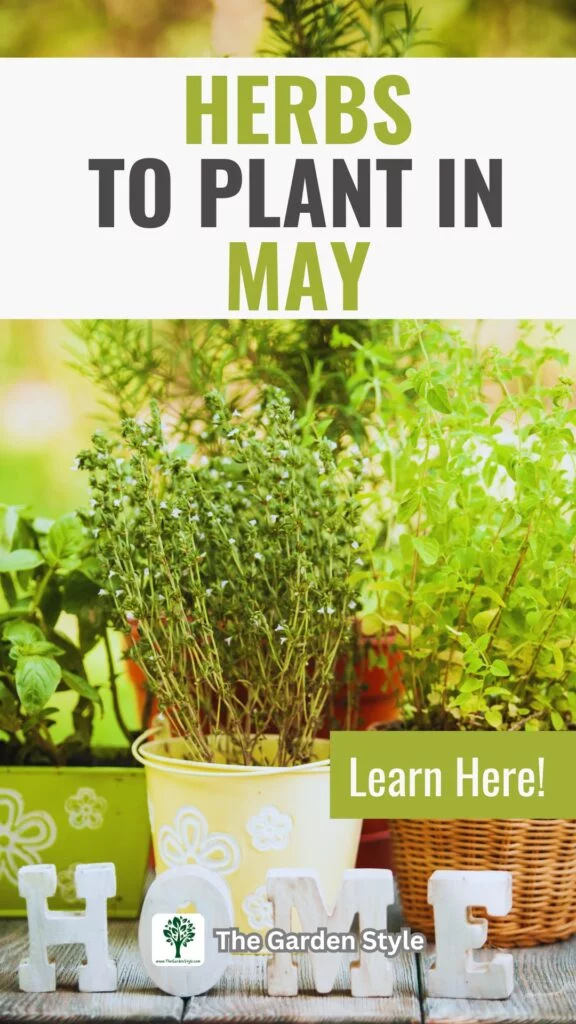
What Herbs Can Be Planted Together
When starting culinary herb seeds or transplanting herb seedlings, be sure to choose wisely what herbs to plant together. Herbs with similar sunlight and water requirements can be effectively planted together in the same container or section of your garden (including a garden bed), creating a harmonious and easy-to-care-for herb garden. Otherwise, you will notice how easily they develop rot roots and decay.
Here are some common combinations based on their sunlight and water needs you should follow when planting herbs together:
Full Sun, Regular Watering
- Basil: Prefers well-drained soil and regular watering. It also grows best in full sun.
- Chives: Thrive in full sun to partial shade and need the soil to be moist but not waterlogged.
- Cilantro: Prefers lots of water and does best in a damp, sunny environment.
- Dill: Prefers full sun and moderate watering.
- Parsley: Prefers full sun, regular watering, and soil that’s rich in organic matter.
Full Sun, Moderate Watering
- Oregano: Prefers full sun and well-drained, light, dry soil.
- Rosemary: Thrives in full sun and prefers well-drained soil. It needs watering when the top of the soil is dry.
- Sage: Prefers full sun and well-drained soil. It needs watering when the top of the soil is dry.
- Thyme: Prefers full sun and well-drained soil. It needs watering when the top of the soil is dry.
Partial Shade, Regular Watering
- Chives: Can grow in partial shade and need the soil to be moist but not waterlogged.
- Cilantro: Can grow in partial shade and prefers lots of water.
- Mint: Can grow in partial shade and prefers moist soil.
- Parsley: Can grow in partial shade, prefers regular watering, and soil that’s rich in organic matter.
- Thyme: Can grow in partial shade and prefers well-drained soil. It needs watering when the top of the soil is dry.
Partial Shade, Moderate Watering
- Mint: Can grow in partial shade and prefers moist soil.
- Thyme: Can grow in partial shade and prefers well-drained soil. It needs watering when the top of the soil is dry.
What am I saying with “partial shade”? In partial shade, herbs generally require around 4 to 6 hours of indirect sunlight per day. Partial shade refers to areas that receive sunlight for only part of the day, typically during the morning or late afternoon, with some protection from direct midday sun.
- CULTIVATE DIVERSE FLAVORS: Grow 15 culinary heirloom herbs in one pack; perfect for diverse recipes. Your culinary herbs seed kit includes the following gardening favorites; arugula, basil, chives, cilantro, dill, garlic chives, lavender, lemon balm, mint, oregano, parsley, peppermint, rosemary, sage, and thyme.
When planting herbs together from seed, it’s essential to consider their growth habits and potential size. Some herbs, like mint, can be “aggressive growers” and may overpower smaller plants if not properly managed. Additionally, ensure the container has adequate drainage to prevent waterlogging, which can lead to root rot.
By grouping herbs with similar needs, you can optimize their growth and ensure they thrive together in the same pot.
Vegetables to Plant in May
These are the vegetables to sow in May.
- Beans (Bush and Pole)
- Where to start: Outdoors
- Soil Temperature: 60-80°F (15-27°C)
- Preferred Location: Sunny, in-ground or large containers
- Light: 6-8 hours of direct sunlight
- Water: Water deeply, but allow soil to dry out slightly between watering
- Days to Maturity: 50-70 days
- Varieties to Grow: Blue Lake (Bush), Kentucky Wonder (Pole)
- Suggested Hardiness Growing Zones: Zones 4-10
- Broccoli
- Where to start: Indoors or outdoors
- Soil Temperature: 45-80°F (7-27°C)
- Preferred Location: Partial shade to full sun, well-drained soil
- Light: 6-8 hours of direct sunlight
- Water: Keep soil consistently moist, especially during head formation
- Days to Maturity: 60-100 days
- Varieties to Grow: Calabrese, Belstar, Broccoli Raab
- Suggested Hardiness Growing Zones: Zones 3-10
- Recommended reading: How to grow broccoli from seed to harvest
- Cabbage
- Where to start: Indoors or outdoors
- Soil Temperature: 45-80°F (7-27°C)
- Preferred Location: Partial shade to full sun, well-drained soil
- Light: 6-8 hours of direct sunlight
- Water: Keep soil consistently moist, especially during head formation
- Days to Maturity: 70-120 days
- Varieties to Grow: Early Jersey Wakefield, Red Acre, Savoy
- Suggested Hardiness Growing Zones: Zones 3-9
- Carrots
- Where to start: Outdoors
- Soil Temperature: 45-85°F (7-29°C)
- Preferred Location: Sunny, well-drained soil
- Light: 6-8 hours of direct sunlight
- Water: Keep soil consistently moist, but not waterlogged
- Days to Maturity: 70-80 days
- Varieties to Grow: Danvers, Nantes, Scarlet Nantes
- Suggested Hardiness Growing Zones: Zones 3-10
- Corn
- Where to start: Outdoors
- Soil Temperature: 60-95°F (15-35°C)
- Preferred Location: Sunny, in-ground
- Light: 6-8 hours of direct sunlight
- Water: Keep soil consistently moist, especially during pollination
- Days to Maturity: 60-100 days, depending on variety
- Varieties to Grow: Sweet corn varieties like Silver Queen, Honey Select, Ambrosia
- Suggested Hardiness Growing Zones: Zones 4-10
- Cucumbers
- Where to start: Outdoors. I strongly recommend always starting cucumber seeds outdoors on the final location and avoiding transferring seedlings as much as possible when growing cucumbers.
- Soil Temperature: 60-95°F (15-35°C)
- Preferred Location: Sunny, in-ground or large containers with trellis
- Light: 6-8 hours of direct sunlight
- Water: Keep soil consistently moist, avoid overhead watering
- Days to Maturity: 50-70 days
- Varieties to Grow: Marketmore, Straight Eight, Lemon
- Suggested Hardiness Growing Zones: Zones 4-10
- Green Beans
- Where to start: Outdoors
- Soil Temperature: 60-80°F (15-27°C)
- Preferred Location: Sunny, in-ground or large containers
- Light: 6-8 hours of direct sunlight
- Water: Water deeply, but allow soil to dry out slightly between watering
- Days to Maturity: 50-65 days
- Varieties to Grow: Blue Lake, Provider, Kentucky Wonder
- Suggested Hardiness Growing Zones: Zones 4-10
- Lettuce
- Where to start: Outdoors or indoors
- Soil Temperature: 45-80°F (7-27°C)
- Preferred Location: Partial shade to full sun, in-ground or containers
- Light: 4-6 hours of direct sunlight
- Water: Keep soil consistently moist, especially during hot weather
- Days to Maturity: 30-70 days, depending on variety
- Varieties to Grow: Butterhead, Romaine, Looseleaf
- Suggested Hardiness Growing Zones: Zones 3-10
- Peppers
- Where to start: Indoors
- Soil Temperature: 70-85°F (21-29°C)
- Preferred Location: Sunny, in-ground or large containers
- Light: 6-8 hours of direct sunlight
- Water: Keep soil consistently moist, avoid overwatering
- Days to Maturity: 60-90 days
- Varieties to Grow: Bell peppers, Jalapenos, Poblano
- Suggested Hardiness Growing Zones: Zones 4-10
- Recommended reading: Best Companion Plants for Peppers (and Plants to Avoid)
- Radishes
- Where to start: Outdoors
- Soil Temperature: 45-85°F (7-29°C)
- Preferred Location: Partial shade to full sun, well-drained soil
- Light: 4-6 hours of direct sunlight
- Water: Keep soil consistently moist, especially during hot weather
- Days to Maturity: 20-30 days
- Varieties to Grow: Cherry Belle, French Breakfast, White Icicle
- Suggested Hardiness Growing Zones: Zones 2-10
- Spinach
- Where to start: Outdoors
- Soil Temperature: 35-75°F (2-24°C)
- Preferred Location: Partial shade to full sun, well-drained soil
- Light: 4-6 hours of direct sunlight
- Water: Keep soil consistently moist, especially during hot weather
- Days to Maturity: 40-50 days
- Varieties to Grow: Bloomsdale, Baby Leaf, Space
- Suggested Hardiness Growing Zones: Zones 3-9
- Tomatoes
- Where to start: Indoors
- Soil Temperature: 70-80°F (21-27°C)
- Preferred Location: Sunny, in-ground or large containers
- Light: 6-8 hours of direct sunlight
- Water: Keep soil consistently moist, but not waterlogged
- Days to Maturity: 60-85 days
- Varieties to Grow: Celebrity, Cherokee Purple, Sungold
- Suggested Hardiness Growing Zones: Zones 4-10
- Recommended reading: How to grow tomatoes from seed to harvest
- Summer Squash (Zucchini, Yellow Squash)
- Where to start: Outdoors
- Soil Temperature: 70-95°F (21-35°C)
- Preferred Location: Sunny, in-ground or large containers
- Light: 6-8 hours of direct sunlight
- Water: Keep soil consistently moist, avoid overhead watering
- Days to Maturity: 45-65 days
- Varieties to Grow: Black Beauty (Zucchini), Golden (Yellow Squash), Crookneck
- Suggested Hardiness Growing Zones: Zones 4-10
- Recommended reading: Growing Zucchini Vertically
I suggest reading our guide about How to Start Seeds Indoors, which provides general guidelines and gardening tips for successful growing.
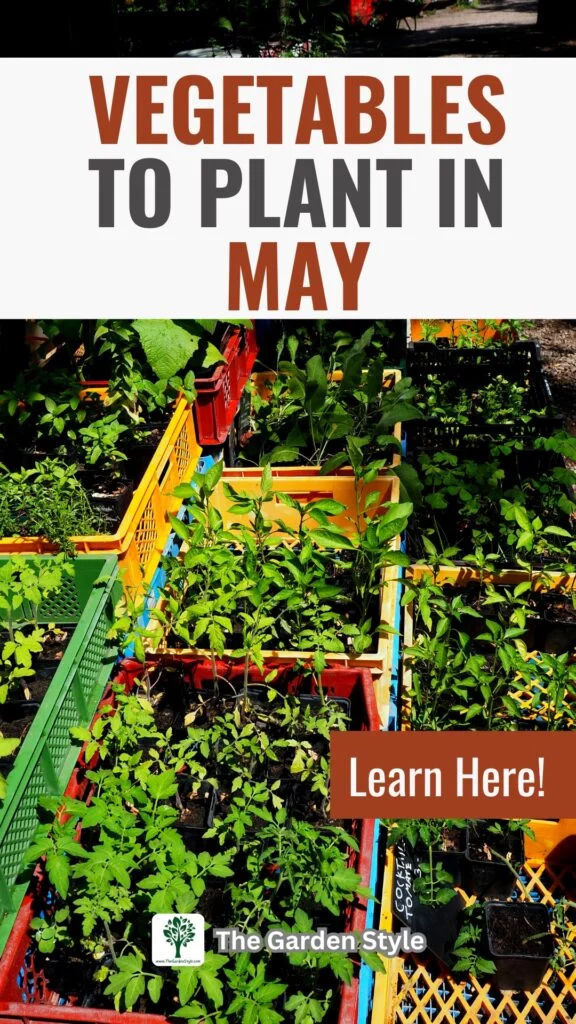
The following tables outline which vegetables can be directly sown into the ground, which ones benefit from starting seeds indoors, and which ones are ready for transplanting as seedlings in May, categorized by different hardiness zones.
Vegetables to Plant in May in Zones 3-5
| Vegetable | Direct Sowing to Ground | Starting Seeds Indoors | Seedlings Ready for Transplanting |
|---|---|---|---|
| Carrots | Yes | No | No |
| Radishes | Yes | No | No |
| Spinach | Yes | No | No |
| Lettuce | Yes | Yes | Yes |
| Cabbage | Yes | Yes | Yes |
| Broccoli | Yes | Yes | Yes |
Vegetables to Plant in May in Zones 6-8
| Vegetable | Direct Sowing to Ground | Starting Seeds Indoors | Seedlings Ready for Transplanting |
|---|---|---|---|
| Carrots | Yes | No | No |
| Radishes | Yes | No | No |
| Spinach | Yes | No | No |
| Lettuce | Yes | Yes | Yes |
| Cabbage | Yes | Yes | Yes |
| Broccoli | Yes | Yes | Yes |
| Green Beans | Yes | No | No |
| Corn | Yes | No | No |
| Cucumbers | Yes | Yes | Yes |
Vegetables to Plant in May in Zones 9-10
| Vegetable | Direct Sowing to Ground | Starting Seeds Indoors | Seedlings Ready for Transplanting |
|---|---|---|---|
| Lettuce | Yes | Yes | Yes |
| Cabbage | Yes | Yes | Yes |
| Broccoli | Yes | Yes | Yes |
| Green Beans | Yes | No | No |
| Corn | Yes | No | No |
| Cucumbers | Yes | Yes | Yes |
| Peppers | Yes | Yes | Yes |
| Tomatoes | Yes | Yes | Yes |
| Summer Squash (Zucchini, Yellow Squash) | Yes | Yes | Yes |
Flowers to Plant in May, Zone by Zone
These are the seeds of flowers to plant in May.
- Alyssum
- Type: Annual
- How and Where to Start: Outdoors, direct sow into the ground
- Soil Temperature: 60-70°F (15-21°C)
- Preferred Location: Sunny to semi-shaded, in-ground or containers
- Light: 4-6 hours of direct sunlight
- Expected Blooming: Spring to fall
- Suggested Hardiness Zones: Zones 3-11
- Bachelor’s Button (Cornflower)
- Type: Annual
- How and Where to Start: Outdoors, direct sow into the ground
- Soil Temperature: 60-70°F (15-21°C)
- Preferred Location: Sunny to semi-shaded, in-ground or containers
- Light: 6-8 hours of direct sunlight
- Expected Blooming: Summer
- Suggested Hardiness Zones: Zones 2-11
- Recommended reading: Cornflowers Planting Guide from Seed
- Black-eyed Susan (Rudbeckia)
- Type: Perennial
- How and Where to Start: Outdoors, direct sow into the ground
- Soil Temperature: 60-70°F (15-21°C)
- Preferred Location: Sunny, in-ground
- Light: 6-8 hours of direct sunlight
- Expected Blooming: Summer to fall
- Suggested Hardiness Zones: Zones 3-9
- Cosmos
- Type: Annual
- How and Where to Start: Outdoors, direct sow into the ground
- Soil Temperature: 60-70°F (15-21°C)
- Preferred Location: Sunny, in-ground or containers
- Light: 6-8 hours of direct sunlight
- Expected Blooming: Summer to fall
- Suggested Hardiness Zones: Zones 2-11
- Dahlia
- Type: Perennial
- How and Where to Start: Outdoors, plant tubers directly into the ground after the last frost
- Soil Temperature: 60-70°F (15-21°C)
- Preferred Location: Sunny, well-drained soil
- Light: 6-8 hours of direct sunlight
- Expected Blooming: Summer to fall
- Suggested Hardiness Zones: Zones 8-11
- Delphinium
- Type: Perennial
- How and Where to Start: Indoors (from seeds) or outdoors (from transplants)
- Soil Temperature: 60-70°F (15-21°C)
- Preferred Location: Full sun to partial shade, well-drained soil
- Light: 6-8 hours of direct sunlight
- Expected Blooming: Summer
- Suggested Hardiness Zones: Zones 3-7
- Recommended reading: How to Grow and Care for Delphinium Flowers
- Lavender
- Type: Perennial
- How and Where to Start: Indoors (from seeds or cuttings) or outdoors (from transplants)
- Soil Temperature: 70-75°F (21-24°C)
- Preferred Location: Full sun, well-drained soil
- Light: 6-8 hours of direct sunlight
- Expected Blooming: Summer
- Suggested Hardiness Zones: Zones 5-9
- Recommended reading: How to Propagate Lavender: A Step-by-Step Guide
- Lisianthus
- Type: Annual or Perennial (depending on variety)
- How and Where to Start: Indoors, start seeds indoors 8-10 weeks before transplanting outdoors after the last frost. Purchasing Lisianthus plugs and transferring them is also a suitable option when growing cut flowers for profit.
- Soil Temperature: 70-80°F (21-27°C)
- Preferred Location: Full sun to partial shade, well-drained soil
- Light: 6-8 hours of direct sunlight
- Expected Blooming: Summer to fall
- Suggested Hardiness Zones: Zones 8-10
- Recommended reading: Growing Lisianthus from Seeds and Plugs
- Marigold
- Type: Annual
- How and Where to Start: Outdoors, direct sow into the ground
- Soil Temperature: 70-75°F (21-24°C)
- Preferred Location: Sunny, in-ground or containers
- Light: 6-8 hours of direct sunlight
- Expected Blooming: Summer to fall
- Suggested Hardiness Zones: Zones 2-11
- Recommended reading: Tips for Growing Marigolds from Seed
- Peony
- Type: Perennial
- How and Where to Start: Outdoors, plant bare-root divisions or container-grown plants in well-prepared soil
- Soil Temperature: 60-70°F (15-21°C)
- Preferred Location: Full sun to partial shade, well-drained soil
- Light: 6-8 hours of direct sunlight
- Expected Blooming: Late spring to early summer
- Suggested Hardiness Zones: Zones 3-8
- Petunia
- Type: Annual
- How and Where to Start: Indoors, start seeds indoors 6-8 weeks before transplanting outdoors after the last frost
- Soil Temperature: 65-70°F (18-21°C)
- Preferred Location: Sunny to semi-shaded, in-ground or containers
- Light: 6-8 hours of direct sunlight
- Expected Blooming: Summer to fall
- Suggested Hardiness Zones: Zones 9-11
- Sunflower
- Type: Annual
- How and Where to Start: Outdoors, direct sow into the ground
- Soil Temperature: 70-85°F (21-29°C)
- Preferred Location: Sunny, in-ground
- Light: 6-8 hours of direct sunlight
- Expected Blooming: Summer to fall
- Suggested Hardiness Zones: Zones 2-11
- Zinnia
- Type: Annual
- How and Where to Start: Outdoors, direct sow into the ground
- Soil Temperature: 70-75°F (21-24°C)
- Preferred Location: Sunny, in-ground or containers
- Light: 6-8 hours of direct sunlight
- Expected Blooming: Summer to fall
- Suggested Hardiness Zones: Zones 3-10
Remember to adapt the planting specifics based on your local climate and soil conditions.

If your intention is to sow cutting flowers, then I suggest reading our guide to planning how to start a cut flower garden. You can explore layouts and learn how to combine perennial and annual flowers. Or you may be interested in growing the easiest flowers from seed this season. So, follow the link to our article 20 Easy Flowers to Grow in Pots for Long-lasting Garden Blooms.
The following tables provide an overview of which flowers can be directly sown into the ground, which ones benefit from starting seeds indoors, and which ones are ready for transplanting as seedlings in May, categorized by different hardiness zones.
Flowers to Plant in May in Zones 3-5
| Flower | Direct Sowing to Ground | Starting Seeds Indoors | Seedlings Ready for Transplanting |
|---|---|---|---|
| Alyssum | Yes | No | No |
| Bachelor’s Button | Yes | No | No |
| Black-eyed Susan | Yes | No | No |
| Cosmos | Yes | No | No |
| Delphinium | Yes | Yes | Yes |
| Lavender | No | Yes | Yes |
Flowers to Plant in May in Zones 6-8
| Flower | Direct Sowing to Ground | Starting Seeds Indoors | Seedlings Ready for Transplanting |
|---|---|---|---|
| Alyssum | Yes | No | No |
| Bachelor’s Button | Yes | No | No |
| Black-eyed Susan | Yes | No | No |
| Cosmos | Yes | No | No |
| Delphinium | Yes | Yes | Yes |
| Lavender | No | Yes | Yes |
| Marigold | Yes | Yes | Yes |
Flowers to Plant in May in Zones 9-10
| Flower | Direct Sowing to Ground | Starting Seeds Indoors | Seedlings Ready for Transplanting |
|---|---|---|---|
| Alyssum | Yes | No | No |
| Cosmos | Yes | No | No |
| Lavender | No | Yes | Yes |
| Marigold | Yes | Yes | Yes |
| Petunia | Yes | Yes | Yes |
| Sunflower | Yes | No | No |
| Zinnia | Yes | No | No |
Fruits to Plant in May
Here’s a list of fruits to plant in May in the USA in the following zones. As you will see below, I suggest not growing some fruit trees from seeds, as it is not a recommended method, so pay attention to that gardening tip.
- Apples
- How and Where to Start: Usually planted as bare-root trees. Plant in well-drained soil in a sunny location.
- Soil Temperature: 60-75°F (15-24°C)
- Preferred Location: Full sun.
- Light: 6-8 hours of direct sunlight.
- Days to Maturity: Apples can take 2 to 10 years to bear fruit, depending on the rootstock and variety.
- Suggested Hardiness Zones: Zones 3-9
- Blueberries
- How and Where to Start: Usually planted as potted plants. Plant in acidic, well-draining soil either in containers or in-ground.
- Soil Temperature: 60-70°F (15-21°C)
- Preferred Location: Full sun for highbush varieties, partial shade for lowbush varieties.
- Light: 6-8 hours of direct sunlight for highbush, 4-6 hours for lowbush.
- Days to Maturity: Blueberries typically start producing fruit in 2 to 3 years after planting.
- Suggested Hardiness Zones: Zones 3-9
- Cantaloupe
- How and Where to Start: Usually started from seed indoors 3-4 weeks before the last frost date, then transplanted outdoors after the danger of frost has passed.
- Soil Temperature: 70-95°F (21-35°C)
- Preferred Location: Full sun.
- Light: 6-8 hours of direct sunlight.
- Days to Maturity: Depending on the variety, cantaloupes can take 70-90 days to mature.
- Suggested Hardiness Zones: Zones 4-10
- Recommended reading: How to Plant Cantaloupe Seeds: A Beginner’s Guide
- Cherries
- How and Where to Start: Usually planted as bare-root trees. Plant in well-drained soil in a sunny location.
- Soil Temperature: 60-75°F (15-24°C)
- Preferred Location: Full sun.
- Light: 6-8 hours of direct sunlight.
- Days to Maturity: Cherries can start producing fruit in 3 to 5 years after planting.
- Suggested Hardiness Zones: Zones 4-9
- Grapes
- How and Where to Start: Usually planted as bare-root vines or potted plants. Plant in well-drained soil in a sunny location.
- Soil Temperature: 60-70°F (15-21°C)
- Preferred Location: Full sun.
- Light: 6-8 hours of direct sunlight.
- Days to Maturity: Grapes typically start producing fruit in 2 to 3 years after planting.
- Suggested Hardiness Zones: Zones 4-9
- Peaches
- How and Where to Start: Usually planted as bare-root trees. Plant in well-drained soil in a sunny location.
- Soil Temperature: 65-75°F (18-24°C)
- Preferred Location: Full sun.
- Light: 6-8 hours of direct sunlight.
- Days to Maturity: Peaches typically start producing fruit in 2 to 4 years after planting.
- Suggested Hardiness Zones: Zones 5-9
- Raspberries
- How and Where to Start: Usually planted as bare-root crowns or potted plants. Plant in well-drained soil, preferably in a raised bed or container.
- Soil Temperature: 60-75°F (15-24°C)
- Preferred Location: Full sun is best for fruit production.
- Light: 6-8 hours of direct sunlight.
- Days to Maturity: Summer-bearing raspberries typically fruit in their second year. Everbearing raspberries may produce fruit the first year.
- Suggested Hardiness Zones: Zones 3-9
- Strawberries
- How and Where to Start: Usually planted as bare-root crowns or potted plants. Plant in well-prepared soil, either in containers or in-ground.
- Soil Temperature: 60-75°F (15-24°C)
- Preferred Location: Sunny to semi-shaded location.
- Light: 6-8 hours of direct sunlight.
- Days to Maturity: Depending on the variety, strawberries can take 4 to 6 weeks to produce fruit after flowering.
- Suggested Hardiness Zones: Zones 3-10
- Watermelon
- How and Where to Start: Usually started from seed indoors 3-4 weeks before the last frost date, then transplanted outdoors after the danger of frost has passed.
- Soil Temperature: 70-95°F (21-35°C)
- Preferred Location: Full sun.
- Light: 6-8 hours of direct sunlight.
- Days to Maturity: Depending on the variety, watermelons can take 70-90 days to mature.
- Suggested Hardiness Zones: Zones 4-10
These fruits offer a variety of flavors and can thrive when planted in May in various regions of the USA, depending on the specific hardiness zone and growing conditions.
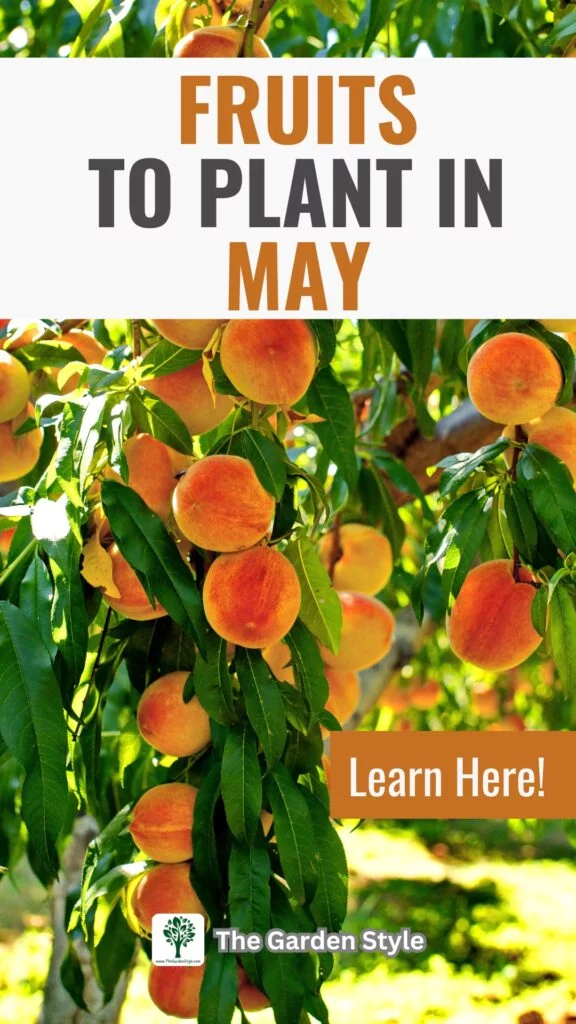
Here are a few tables summarizing the fruits to grow in May for different hardiness zones, categorized by direct sowing, starting seeds indoors, and seedlings ready for transplanting:
Fruits to Plant in May in Zones 3-5
| Fruit | Direct Sowing to Ground | Starting Seeds Indoors | Seedlings Ready for Transplanting |
|---|---|---|---|
| Apples | No | Yes | Yes |
| Blueberries | No | Yes | Yes |
| Cherries | No | Yes | Yes |
| Grapes | No | Yes | Yes |
| Peaches | No | Yes | Yes |
| Raspberries | No | Yes | Yes |
| Strawberries | Yes | No | No |
| Watermelon | Yes | Yes | Yes |
Fruits to Plant in May in Zones 6-8:
| Fruit | Direct Sowing to Ground | Starting Seeds Indoors | Seedlings Ready for Transplanting |
|---|---|---|---|
| Apples | No | Yes | Yes |
| Blueberries | No | Yes | Yes |
| Cantaloupe | Yes | Yes | Yes |
| Cherries | No | Yes | Yes |
| Grapes | No | Yes | Yes |
| Peaches | No | Yes | Yes |
| Raspberries | No | Yes | Yes |
| Strawberries | Yes | No | No |
| Watermelon | Yes | Yes | Yes |
Fruits to Plant in May in Zones 9-10:
| Fruit | Direct Sowing to Ground | Starting Seeds Indoors | Seedlings Ready for Transplanting |
|---|---|---|---|
| Apples | No | Yes | Yes |
| Blueberries | No | Yes | Yes |
| Cantaloupe | Yes | Yes | Yes |
| Grapes | No | Yes | Yes |
| Peaches | No | Yes | Yes |
| Raspberries | No | Yes | Yes |
| Strawberries | Yes | No | No |
| Watermelon | Yes | Yes | Yes |
Save this pin for later and share this gardening calendar with friends and family.
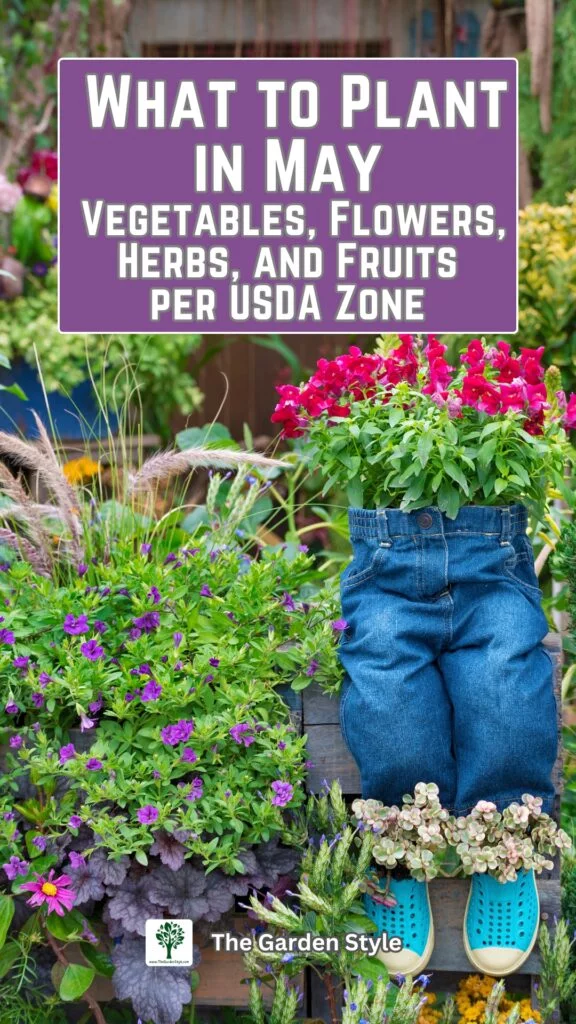
Final Thoughts
May is an excellent month to continue planting in the vegetable and flower garden. A wide variety of flowers and vegetables grow in May, and the risk of frost is over in many areas.
Spring comes alive in May, take advantage of this month to give life to your orchard!


